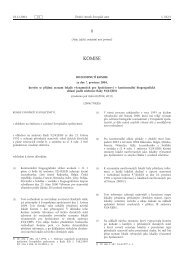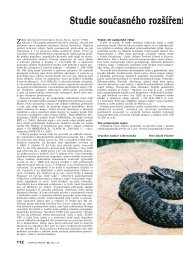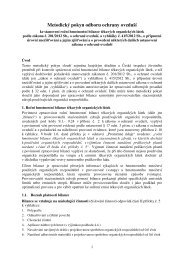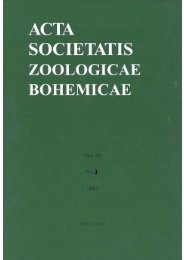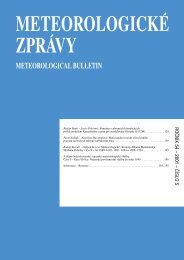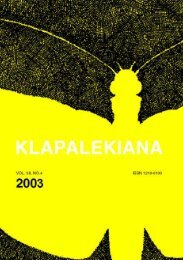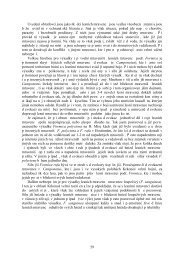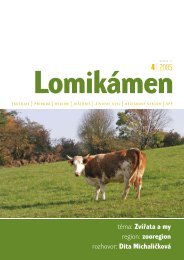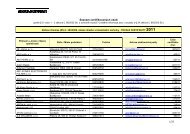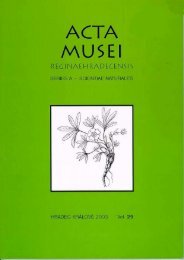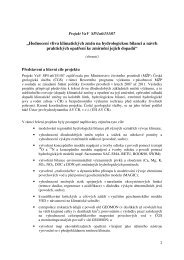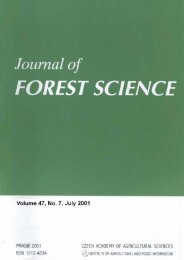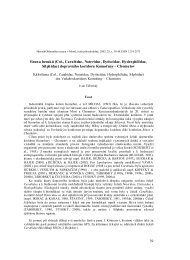Distribution and taxonomy of some Synapsis species, with ...
Distribution and taxonomy of some Synapsis species, with ...
Distribution and taxonomy of some Synapsis species, with ...
Create successful ePaper yourself
Turn your PDF publications into a flip-book with our unique Google optimized e-Paper software.
phuga atrata lombarda Depoli, 1931 as junior objective synonyms <strong>of</strong> Phosphuga atrata atrata<br />
(Linnaeus, 1758).<br />
Silpha carinata Herbst, 1783<br />
Silpha carinata Herbst, 1783: 34.<br />
Silpha italica Küster, 1851: no. 15; syn. n.<br />
Silpha lunata var. austriaca Otto, 1891: 59; syn. n.<br />
Silpha carinata var. blattiformis Reitter, 1901: 121; syn. n.<br />
COMMENTS. Silpha carinata is a widely distributed Palaearctic <strong>species</strong>, known from Europe to<br />
Siberia (Šustek 1983). This polymorphic <strong>species</strong> was reviewed by Šustek (1983), who treated<br />
several names as junior subjective synonyms <strong>of</strong> S. carinata, <strong>and</strong> discussed the variability <strong>of</strong> this<br />
<strong>species</strong> in relation to altitude <strong>and</strong> length <strong>of</strong> vegetation period <strong>with</strong>in its distributional area.<br />
Küster (1851) described a large, black, vaulted specimen from “Italia” as Silpha italica. Otto<br />
(1891) described small, black, vaulted specimens from “Ostalpen” as Silpha lunata var. austriaca.<br />
Šustek (1983) treated both these names as valid sub<strong>species</strong> <strong>of</strong> S. carinata, although he argued<br />
that they are only ecomorphs <strong>of</strong> this <strong>species</strong>. Further, he introduced the following evolutionary<br />
scenario (however, <strong>with</strong>out any exact chronology): montane populations <strong>of</strong> S. carinata austriaca<br />
(<strong>with</strong> small, black, vaulted body) from central European mountain systems penetrated into Italy,<br />
where they become S. carinata italica (<strong>with</strong> larger body, but still black <strong>and</strong> heavy vaulted in<br />
comparison to lowl<strong>and</strong> populations <strong>of</strong> S. carinata carinata from the rest <strong>of</strong> Europe, also more<br />
flattened <strong>and</strong> usually <strong>with</strong> at least <strong>some</strong> brownish coloured individuals). In my opinion, it is not<br />
possible to distinguish morphologically both ecomorphs delimited by Šustek (1983) from S. carinata<br />
carinata. Moreover, the mountain populations <strong>of</strong> the Alps, Bohemian massif <strong>and</strong> the Carpathians<br />
are not reproductively isolated from populations from neighbouring areas; body size<br />
decreases <strong>with</strong> increase in altitude (as already demonstrated by Šustek 1983), <strong>and</strong> the vaulting <strong>of</strong><br />
elytra in central European populations is not correlated <strong>with</strong> body size.<br />
Reitter (1901) described large, elongate, black, distinctly flattened specimens <strong>with</strong> less developed<br />
costae from “Turkestan” (probably from the territory <strong>of</strong> nowadays Kazakhstan) as Silpha<br />
carinata var. blattiformis. Šustek (1983) treated it as a junior subjective synonym <strong>of</strong> S. carinata<br />
carinata, but Nikolaev & Kozminykh (2002) recently removed it from synonymy <strong>with</strong> S. carinata<br />
carinata <strong>and</strong> treated it as S. carinata blattiformis. I have examined specimens from Kazakhstan<br />
(deposited in JRUC <strong>and</strong> JSCC) <strong>and</strong> considered that except for the more flattened elytra <strong>with</strong> weakly<br />
developed costae, other characters mentioned by Reitter (1901) fall <strong>with</strong>in the variation <strong>of</strong> European<br />
populations <strong>of</strong> S. carinata.<br />
Consequently, I consider Silpha carinata italica Küster, 1851, Silpha carinata austriaca Otto,<br />
1891 <strong>and</strong> Silpha carinata blattiformis Reitter, 1901 as junior subjective synonyms <strong>of</strong> Silpha<br />
carinata Herbst, 1783.<br />
Silpha melanura Hope, 1831<br />
Silpha melanura Hope, 1831: 21.<br />
Silpha nakanei Emetz et Schawaller, 1975: 227; syn. n.<br />
TYPE MATERIAL EXAMINED. HT male <strong>of</strong> Silpha melanura (BMNH), labelled “Type [round label <strong>with</strong> red margin] //<br />
Nepal. [yellow label] // Hardw. / Bequest // melanura Hope [hw]”.<br />
ADDITIONAL MATERIAL EXAMINED. 1 male, 1 female (JRUC): “Nepal: Kathm<strong>and</strong>u distr., Siwapuri Dara, 2300–2550 m,<br />
29.iv. –2.v.1985, A. Smetana leg.”; 1 male, 1 female (JRUC): “Nepal: Bagmati, Sindhupalchok: Manegero, 2100–<br />
2500 m, 12. –14.vi.1989, C. Holzschuh leg.”.<br />
309



